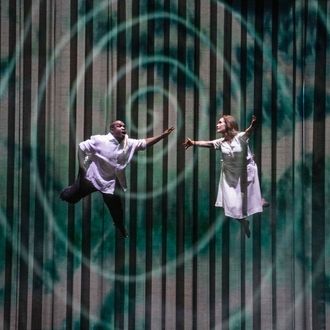
It’s whiplash Mozart time at the Metropolitan Opera. Two weeks after opening its dour new Don Giovanni, directed by Ivo van Hove, the Met has followed it with Simon McBurney’s doggedly whimsical staging of Die Zauberflöte. Obligatory scowls have been replaced with obligatory grins. Van Hove applies his claustrophobic focus, and McBurney sends so many concepts fluttering around the stage that it’s hard to keep track of what they all portend. A few land gracefully; most bang against each other and expire.
The centerpiece of Michael Levine’s set for Die Zauberflöte is a platform that dangles in midair, dipping dangerously at one corner or tilting as if trying to dislodge the singers. We get it: It’s a literally destabilizing device, a form of resistance to the plot’s mystical mumbo jumbo and patriarchal rites of passage. At least McBurney wants the audience to have a good time — he demands it, in fact. So we get Thomas Oliemans singing the shambolic birdman Papageno as a Jack-of-no-real-trades in a high-viz vest, a folding ladder over his shoulder, Buster Keaton–ing around the stage, sprinting down the aisle, and popping into the audience for a quick flirtation with a lady in the third row. So far, so funny. Then Stephen Milling, as the high priest Sarastro, saunters along a passerelle with a microphone in his fist, part smooth-sermonizing televangelist, part corporate boss. Lawrence Brownlee as Tamino appears (then instantly collapses) in a purple tracksuit that the three ladies strip off him, jumping from lusty admiration to a little light sexual abuse. Are you not entertained?
At its best, the staging has a “Watch me!” swagger, a principled refusal to ply the audience with whiz-bang illusion. Two unscripted cast members flank the proscenium. At stage left is Ruth Sullivan, a Foley artist with a cabinet of sonic wonders, who supplies thunder, birdcalls, and the amplified noise of roaring flames and bubbling water. Across the stage, in a studio of his own, is the visual artist Blake Habermann, who quickly scribbles stage directions, mountains, and rays of sunshine onto a blackboard. His live sketches and rhythmic erasures get projected onto a scrim in real time.
These techniques have power. Like a sleight-of-hand entertainer, McBurney’s letting us look up his sleeve, demonstrating that a trick retains its magic even when the audience can see how it’s done. A corps of handlers manipulates paper birds. The orchestra, instead of being hidden in the pit, is lifted into sight. The strategy works because music-making usually takes place out in the open anyway: Seeing a violinist’s fingers dart over the instrument’s neck doesn’t detract from the miracle of the player’s technique.
Well, it’s semi-principled. By the end, when the score leads Tamino and Pamina on a stately march through trials, the production resorts to digital projections of flames and floods that might have been startling a decade ago but now look no more alarming than a televised Yule log.
Despite his assorted subversions, McBurney sometimes winds up substituting one creaky narrative with another. The Queen of the Night isn’t the usual icy beauty; instead, she’s a stiff-jointed old witch hurling herself around in a wheelchair. Kathryn Lewek sings the role with headlong bravura, giving her scenes an exhilarating buzz, but the character the director has fashioned undermines his desire to retool convention: What could be a lazier use of stereotype than conflating disability and age with evil?
McBurney and his team created this production for the Dutch National Opera in 2012, and it has traveled around since then. Maybe it works better in a more intimate house, but at the Met, the homemade, improv-night aesthetic wears thin. Costume designer Nicky Gillibrand seems to have bought his costumes on sale at T.J. Maxx. Sarastro’s Masonic minions gather around a conference table in generic gray suits, Tamino heads off in pursuit of virtue wearing a white shirt and black pants, and Pamina does a lot of entreating in a frumpy white dress. Evidently, the store was out of bright clothing, making this would-be effervescent production as monochrome as that funereal Don Giovanni.
Fortunately, the music-making has color to spare. Brownlee is an adorably sweet-voiced Tamino, though his singing lacks a hero’s brassy clang so that he plods a little confusedly toward redemption. The wonderful Erin Morley scrubs the simper off Pamina — hers is a wiser, more determined girlfriend than we usually get — but not even she can endow her with enough badassery to rough up the gender roles. That’s the problem with trying to modernize 18th-century artifacts: Often, you just wind up accentuating the distance between what a work is and what we would like it to be. The conductor Nathalie Stutzmann coordinates the performance’s million moving parts with relaxed confidence and an ear for detail. These days, she’s battling directors in two Mozart operas at the same time. She should get a medal for making auteurs sound as good as they do; better yet, she should be paired with a director who shares her genuine sympathy for the score.
The Magic Flute is at the Metropolitan Opera through June 10.





